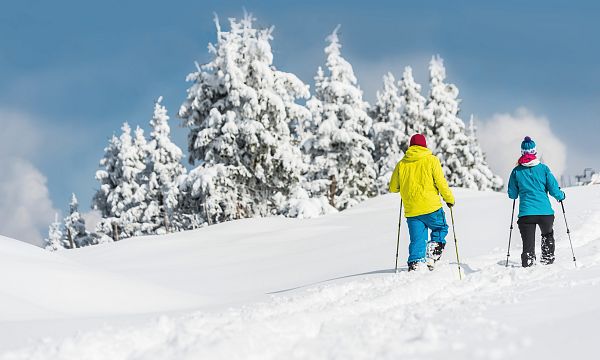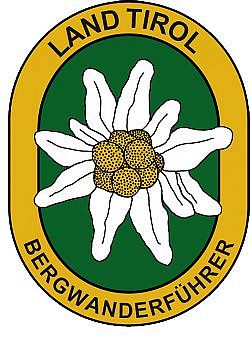SAFE Snowshoeing and Winter Hiking
Tips and advice for your safety on the mountain
As an outdoor sport, snowshoeing offers many health and social benefits.
However, safety is the top priority alongside your mountain experience. It is therefore important that you observe and adhere to essential rules of behaviour and instructions. In addition, accurate tour planning and adequate equipment are essential for a safe winter and snowshoe hike. All recommendations and information can be found below.
The following ten recommendations from the Austrian Alpine Association are designed to make your winter and snowshoe hike as safe and enjoyable as possible.
Winter and snowshoe hiking are endurance sports. The beneficial physical stress placed on the heart and circulatory system requires good overall health and a realistic self-assessment. Avoid time pressure and choose a pace that allows everyone in the group to stay within their limits and avoid overexertion.
Hiking maps, guide books, the internet and experts will inform you about the length, altitude difference, difficulty and current conditions. Always tailor your tours to the group and pay particular attention to the weather and avalanche report, as precipitation, wind and cold increase the risk of accidents.
Tour planning checklist
- Suitable choice of tour destination according to your own ability and fitness as well as the current snow conditions? (honest self-assessment - physical and mental requirements; please note that many mountain tours are not feasible in winter due to snow).
- Plan your time! Set off early - dusk sets in at around 4 pm in winter. Pay attention to the time of day when it warms up (avalanche risk increases!)
- Dealing with the topics of orientation and avalanche danger?
- Observe the weather forecast and current weather conditions
- Installation and test run of the "SOS-EU-Alp" emergency call app on your smartphone
- Taking out accident and rescue costs insurance
- Conditions can change – assess them at the trailhead
- Suitable choice of equipment
Possible alpine dangers include:
Sudden changes in weather, snowfall, strong winds, avalanches, fog, icy terrain, and intense sunlight (warming during the day can increase the risk of avalanches).
Weather conditions can alter the terrain significantly from one day to the next. For this reason, it is up to each individual to carefully assess the situation and take full responsibility for judging whether an ascent is safe.
Recommendation: Salvage insurance
Rescue missions in the mountains are not free of charge! If you take out mountain cost insurance in good time (e.g. travel insurance from Europäische Reiserversicherung or as a sponsor of the Tyrolean Mountain Rescue Service, as a member of the Alpine Club, via ÖAMTC/ADAC or credit card and private accident insurance), your mountain costs can be covered by the insurance up to the amount defined in each case.
Attention! Health insurance companies do not pay for rescue from alpine emergencies!

Current avalanche report Tyrol
Here you will find all information on regional avalanche danger levels, snowpack structure, danger patterns, trends, alpine weather reports and much more.
Or you can get real-time information on the current avalanche situation via the "Avalanche Tirol" app.
Download for iOS devices
Download for Android devices
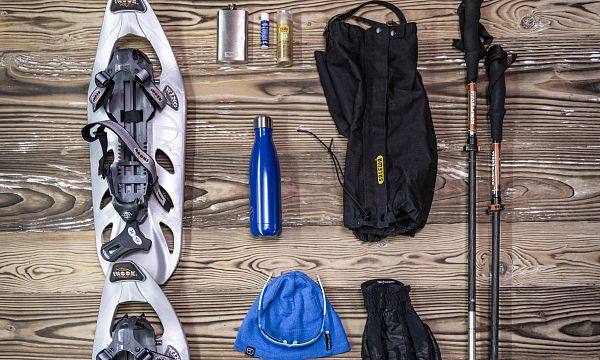
The right equipment for winter and snowshoe hikes.
Adapt your equipment to your trip and make sure your rucksack is light. Rain, cold and sun protection should always be in your rucksack, as well as a first aid kit and your mobile phone (Euro emergency number 112). Maps, apps or GPS will help you find your way.
Checklist
- Footwear: sturdy, high, waterproof mountain boots with grippy tread soles
- Clothing: windproof and waterproof, breathable jacket, insulating jacket, fleece/soft shell jacket, hat and gloves, functional underwear, change of underwear
- Sun protection: high-quality sunglasses, headgear, sun cream (protection factor = 30), lip protection
- Drinks and food: min. 1 to max. 2 litres of water/tea, fruit/cereal bars, trail mix or simply anything that tastes good
- Map material: Winter hiking map, tour description and information material
- Mobile phone: Ensure sufficient battery charge (emergency), carry a power bank if necessary
- First aid package incl. blister plasters and aluminium rescue blanket
- Backpack: volume approx. 25 litres
- Bivouac sack & headlamp
- Snowshoes: Adapted to size and weight
- Avalanche equipment: depending on the tour in open terrain, also avalanche transceiver, probe and shovel
- Documents: ID, insurance card, cash
- Walking poles: When used correctly, poles help to relieve pressure on the joints and support balance. However, our natural balance and coordination skills are negatively affected. Make sure that telescopic poles have a reliable locking mechanism.
Additional equipment for alpine winter hiking trails or tours in open/alpine terrain:
- Sturdy, high mountain boots with grippy tread soles (waterproof)
- Gaiters if necessary
- Grödel / snow spikes if necessary
- Avalanche equipment: avalanche transceiver, probe and shovel
- Bivy bag & headlamp
Sturdy mountaineering boots protect and relieve the foot and improve surefootedness! When making your choice, look out for a perfect fit, non-slip tread sole, waterproofness and low weight.
Falls as a result of slipping or tripping are the most common cause of accidents! Please note that excessive speed or fatigue can severely impair your surefootedness and concentration. Take particular care when descending!
When venturing off marked trails, the risk of losing your orientation or falling increases. Avoid taking shortcuts, and if you lose your way, retrace your steps to the last clearly recognisable point.
In snowy conditions, trail signs and ground markings may be completely hidden.
Resting in good time helps you to relax, enjoy the scenery and socialise. Eating and drinking are necessary to maintain performance and concentration. Isotonic drinks are ideal thirst quenchers.
Please note that the focus is on variety and playful discovery for children! In passages where there is a risk of falling, one adult can only supervise one child. Very exposed routes that require prolonged concentration are not suitable for children.
Small groups ensure flexibility and enable mutual help. Inform people you know about your destination, route and return. Stay together in the group. Beware lone hikers: even minor incidents can lead to serious emergencies.
To protect mountain nature: do not leave any rubbish behind, avoid noise, stay on the paths, do not disturb wild animals, leave plants untouched and respect protected areas. Use public transport or form car pools to get there.
Respect protected and conservation areas for plants and animals !
Consideration for wild animals in winter
Due to the scarcity of food, wild animals reduce their metabolism in winter and are unable to compensate for energy losses when disturbed. Therefore:
- Avoid twilight (time of feeding and grazing) - it is best to plan your tour from 90 minutes after sunrise and up to 90 minutes before sunset. Night hikes and descents should be avoided if at all possible.
- Avoid feeding grounds and feeding areas over large areas (300 metres) (observe restricted areas!).
- Only observe animals from a distance, never chase them.
- Behave calmly and do not shout.
Protect Young Forests
Only healthy young trees can grow into a strong forest that protects us from dangers such as avalanches, mudslides or rockfall - skis, snowshoes and careless behaviour can severely damage young trees. The following therefore applies: Do not enter reforested areas and young forests.
Dogs
Dogs are perceived as a threat by wild animals and should be kept on a lead - this also prevents problems with other winter sports enthusiasts.
We also ask you to use dog waste bags and not to leave them lying around, but to throw them in the nearest rubbish bin.
Rubbish
Nature is a precious resource! Rubbish has no place in nature and belongs in the designated rubbish bins! So please take your rubbish with you into the valley - otherwise it will still be there the next time you visit.
How long does the waste lie on the mountain - rotting times at a glance
- Banana peel: 1-3 years
- Paper handkerchief: 1-5 years
- Chewing gum: 5 years
- Cigarette butts: 2-7 years (+ chemicals, heavy metals)
- Tin cans: 50-500 years
- Battery: 100-1,000 years (+ chemicals, heavy metals)
- Plastic bottle: 100-5,000 years
- Plastic bag: 120-1,000 years
- Aluminium can: 400-600 years
- Baby nappy, sanitary napkin: 500-800 years
- Glass bottle: 4,000-50,000 years - not measurable
- Styrofoam: 6,000 years - not measurable
"Mountain World Tyrol - Experience together"

Observe rest periods and protection zones for wild animals | Black grouse
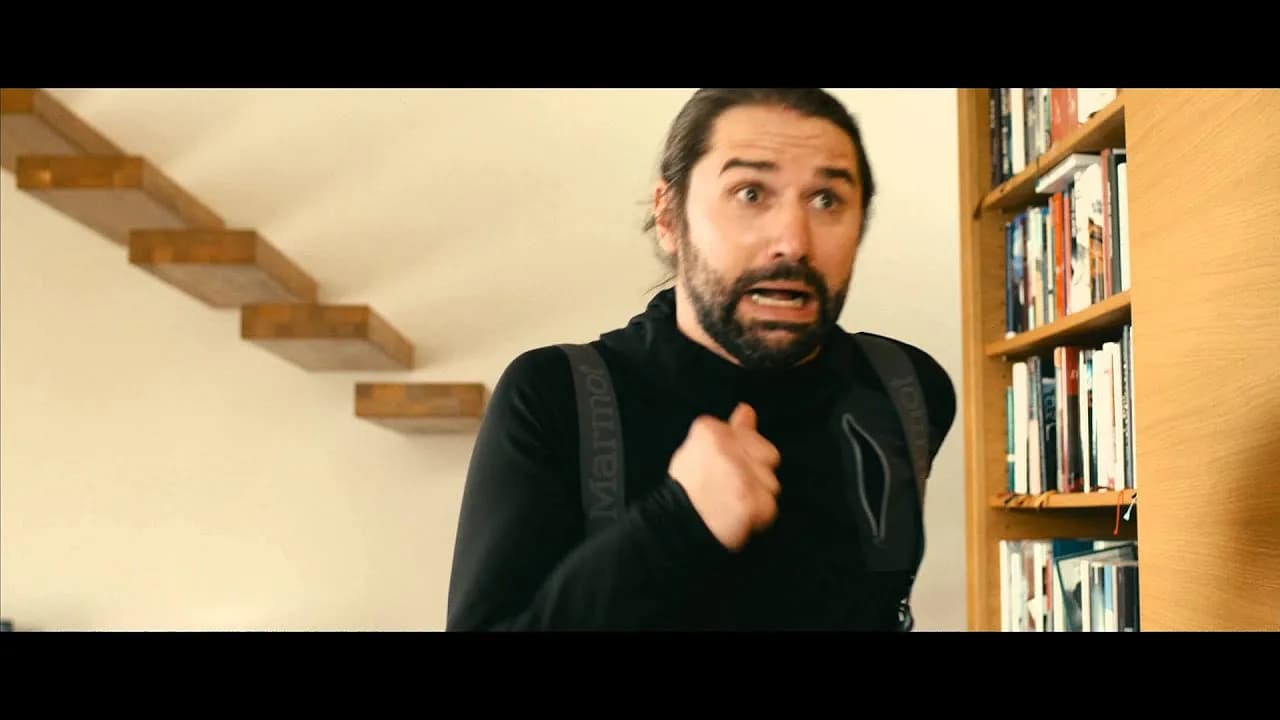
Tip
Emergency numbers
What to do in an emergency?
Dial emergency number
140 - Alpine emergency call (mountain rescue)
112 - European emergency number
133 - Police
144 - Rescue


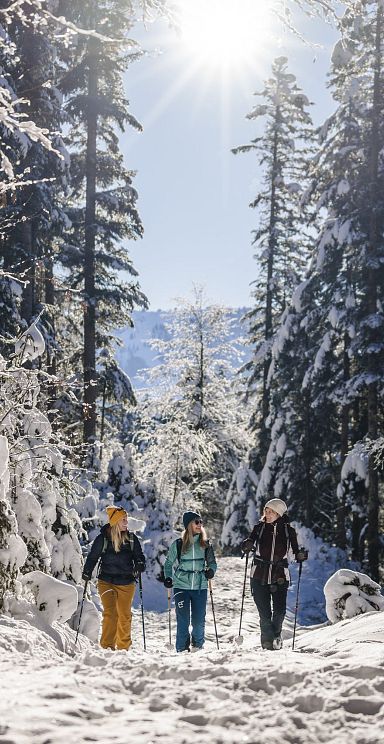
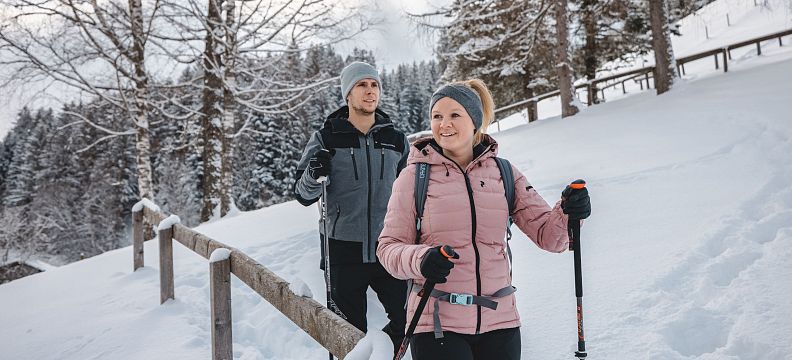
Winter hiking trail guidance system
The winter hiking trails are marked with dark green arrowheads and a white snow star on the yellow summer hiking trail signs or along the cross-country ski trails with green signs.
Take care when leaving the marked winter hiking trails. In snowy conditions, the summer hiking trail network and its markings are not visible - loss of orientation and alpine dangers can be the result. For signposting of winter hiking trails along the summer hiking trail network, see yellow sign below.
Signposting of the winter hiking trails along the cross-country ski trails:
There are two types of use along the cross-country ski trails - winter hiking trails or a combined trail of winter hiking & cross-country skiing (skating trail).
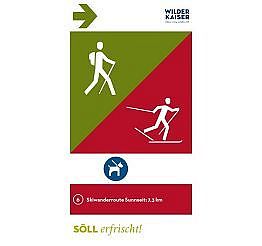
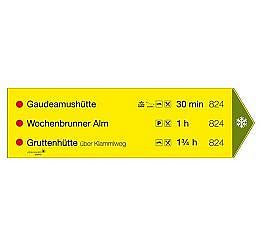

Walking time calculation
Rule of thumb for calculating the walking time for winter hikes (a group of 4 to 6 people):
- approx. 300 metres in altitude per hour for the ascent
- approx. 500 metres in altitude per hour for the descent
- approx. 3 kilometres horizontally per hour
The walking time is calculated separately for the difference in altitude and the horizontal distance. The value of the shorter walking time is halved and added to the longer value.
Example for calculating an ascent time:
A hiking trail runs over 600 metres in altitude (= 2 hours walking time) and 9 horizontal kilometres (= 3 hours walking time). The smaller value is halved. Walking time for the ascent = 1 hour + 3 hours = 4 hours.
Tip
Safely into winter: What the mountain rescuer advises
Find out what is important for winter sports in alpine terrain and why proper tour planning is an important part of it.


